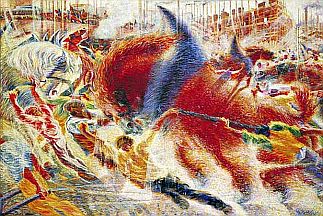Online Talk: Futurismo: The Dehumanization of Art by Béa Aaronson PhD [] JC3
Event Category: Presentations/Discussions
-
Thursday Jan. 7, 3pm
Zoom registrationFuturismo: The Dehumanization of Art
by Béa Aaronson PhD
“A roaring motor car,
which seems to run on machine-gun fire
is more beautiful than
the Victory of the Samothrace!”“We declare that the splendor of the world
has been enriched by a new beauty:
the beauty of speed…
We want to sing the man at the wheel!”
This Italian “ism” is the most radical political art movement of the 20th century. In 1909, Filippo Tommaso Marinetti launched his Futurist Manifesto, like a bolt out of the blue, extolling youth and action, championing violence and conflict, praising “war” as “the only health giver of the world,” the “world’s only hygiene,” and glorifying speed, the machine and technology. You must remember that in the early 1900s, innovations such as electricity, X-rays, radio waves, the automobile and the airplane were extremely exciting, but that Italy was lagging behind Britain, France, Germany and the United States, in the pace of technological and industrial development. Culturally speaking, Italy’s artistic reputation was still grounded in Antiquity, the Renaissance and the Baroque age. Simply put, Italy represented the past. So, a group of young and rebellious Italian writers and artists took upon themselves to discard this passatismo and move into modernity, into the future: futurismo!
Marinetti was the ringleader. Umberto Boccioni, Carlo Carra, Gino Severini, and Giacomo Balla, who enthusiastically named his daughter “Elica” – “Propeller,” decided to get together, determined to celebrate technology as the path to a New World Order. This fever for testosterone art was consanguine with another power…that of Fascism. With his fervent Italian nationalism and imperialism, Marinetti, also known as “the caffeine of Europe,” actually helped Mussolini found the Fascist movement in 1919. I shall talk about this dangerous marriage: how art and politics wed together, not always for the best though…
In its disgust for Italian cultural stagnation, Futurism rebelled against the past. Its incitement to burn down libraries and flood museums enflamed the Italian Zeigeist. Against the past. and also against…pasta! Meat, meat, meat, more meat! I shall unravel for your astonishment the secrets of Futurist gastronomy. Marinetti’s 1931 Futurist Cookbook abhorred passéiste Pasta Eaters who “forget the lofty dynamic obligations of the race and the searing speed and most violent contradictory forces that constitute the agonizing rush of modern life.” Witness this recipe called The Excited Pig in which a whole salami, skinned, is served upright on a dish containing some very hot black coffee mixed with a good deal of eau de Cologne! Or the Chicken Fiat, in which a chicken is roasted with a handful of ball bearings inside: “When the flesh has fully absorbed the flavor of the mild steel balls, the chicken is served with a garnish of whipped cream.” According to Marinetti, a Futurist meal had to be preferably consumed while listening to the soothing hum of an airplane engine!
As far as visual art is concerned, Futurists painters and sculptors espoused Cubist fragmentation and simultaneous perspectives, as well as Muybridge’s and Marey’s pioneering work on motion, to extoll their vision of a fragmented, violent and speedy world. I will show you many examples of their work.
In a combination of outrage and irony, pulsing with the dynamism of an engine-driven civilization, Futurism also changed the face of poetry, music, and architecture. Futurist poets cherished “a violent assault on the forces of the unknown,” manipulating Dada linguistic tricks for their own destructive purpose. Futurist musicians also wanted a liberation from the past of “well-made” music. Luigi Russolo wanted to end all period settings, ballads, and “nauseating Neapolitan songs and sacred music.” He invented his intonarumori, whose acoustic noise generators allowed the performer to control the dynamics and pitch of different noises, including “howlers”, “exploders”, “crumplers”, “hissers”, “scrapers,” voices of animals and people, shouts, screams, shrieks, wails, death rattles, sobs, hoots and howls! Futurist architects rejected stone, wood, all natural elements used in the past, and chose manmade steel, glass and concrete, without any trace of decorative elements, to create the nightmarish world of Sant’Elia’s Citta Nuova.
Whether painters, sculptors, photographers, movie directors, poets, musicians, or architects, the Futurists saw beauty as struggle: “There is no masterpiece that has not an aggressive character.” But when this aggression becomes the core and sole energy of artistic creation, I do believe that Futurism enhanced and encouraged the process of dehumanization from which consequences we are now suffering.
-
-

